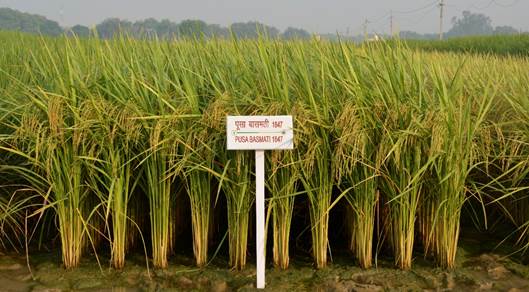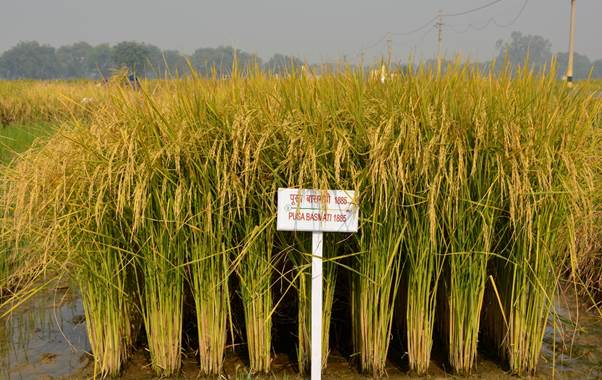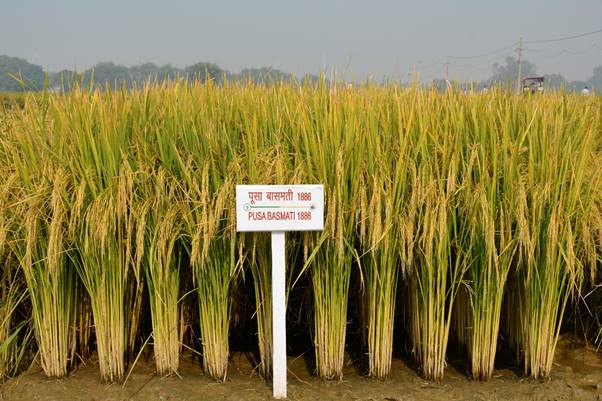Ministry of Agriculture &
Farmers Welfare
IARI organised Kisan Sampark Yatra to obtain farmers’ feedback of newly released IARI Basmati Varieties
Three improved Basmati rice varieties with resistance to both Bacterial blight and blast diseases, paves the way for sustaining India’s leadership in Basmati rice exports across the world
प्रविष्टि तिथि:
30 SEP 2022 6:58PM by PIB Delhi
The Indian Agricultural Research Institute (IARI) organised the ‘Kisan Sampark Yatra’ during September 27-29 in the rice growing region of Haryana and Punjab to obtain farmers’ feedback on the three newly released IARI Basmati varieties. The IARI had distributed 1 kg per acre seeds of the newly developed disease resistant Basmati rice to farmers during the Krishi Vigya Mela held at Pusa, New Delhi earlier this year for cultivation. Briefing the media today, Dr. AK Singh, Director, IARI said farmers were advised not to sell the produce of these seeds in the market, instead provide it to other farmers so that the new varieties could multiply and be grown in larger volumes.
Basmati rice is an export commodity with annual forex earning of Rs. 25,053 crores during 2021-22. Pusa Basmati rice varieties namely, Pusa Basmati 1121, Pusa Basmati 1509 and Pusa Basmati 6 occupy more than 90% of the area under Basmati rice cultivation in GI area of Basmati rice in India and account for more than 90% of the Basmati rice exports from India. Bacterial blight and blast are the most devastating diseases in Basmati rice which cause significant yield losses as well as affect the Basmati grain and cooking quality. Conventionally, these diseases are managed by use of chemicals like streptocyclin and tricyclazole. However, there has been concerns raised by the importing nations especially from the European Union of use of some chemicals in Basmati rice, and in some cases rejection of Basmati rice consignments from the importers. During recent years, European Union has reduced the MRL (residue limit) of tricyclazole (one of the most commonly used fungicide in managing neck blast disease) to 0.01ppm. Therefore, there was an urgent need to address this issue in order to maintain the leading position in the international trade of Basmati rice.
On the directions of the Prime Minister Shri Narendra Modi, the Union Minister of Agriculture and Farmers Welfare, Shri Narendra Singh Tomar tasked the Indian Council of Agricultural Research (ICAR) to address the concerns. IARI, New Delhi, a premier institute under the ICAR, pioneered the research to incorporate resistance to the two diseases through incorporation of genes governing resistance to bacterial blight and blast diseases in the genetic background of the three major varieties, Pusa Basmati 1121, Pusa Basmati 1509 and Pusa Basmati 6 through molecular marker assisted breeding. Through concerted research, ICAR-IARI developed improved version of these three Basmati rice varieties with inbuilt resistance to Bacterial blight and blast diseases with the aid of molecular marker assisted breeding resulting in development and release of Pusa Basmati 1847, Pusa Basmati 1885 and Pusa Basmati 1886 in 2021. The three improved Basmati rice varieties with resistance to both Bacterial blight and blast diseases, would pave the way for sustaining India’s leadership in Basmati rice exports across the world, said Dr. AK Singh.
A brief description of each of these varieties are presented below:
Pusa Basmati 1847 - an improved Bacterial blight and blast resistant version of popular Basmati rice variety, Pusa Basmati 1509:
Pusa Basmati 1847 is an improvement of popular Basmati rice variety, Pusa Basmati 1509 with inbuilt resistance to bacterial blight and blast disease developed through molecular marker assisted breeding. This variety possesses two genes each for bacterial blight resistance namely, xa13 and Xa21; and blast resistance namely, Pi54 and Pi2. It is an early maturing and semi-dwarf Basmati rice variety with average yield of 5.7 t/ ha. This variety was released for commercial cultivation in 2021. Pusa Basmati 1847 is highly resistant to blast disease (susceptibility index of 2.5) as compared to Pusa Basmati 1509, which is highly susceptible (susceptibility index of 7.0). It also exhibits highly resistant reaction against bacterial blight disease (susceptibility index of 3.0) as compared to Pusa Basmati 1509, which is highly susceptible (susceptibility index of 7.0).

Pusa Basmati 1885 - an improved Bacterial blight and blast resistant version of popular Basmati rice variety, Pusa Basmati 1121:
Pusa Basmati 1885 is an improved version of Pusa Basmati 1121 with inbuilt resistance to bacterial blight and blast diseases. This variety has been developed through molecular marker assisted breeding incorporation of two genes each for bacterial blight resistance namely, xa13 and Xa21; and blast resistance genes Pi2 and Pi54. It has semi-tall plant stature with extra-long slender grains and cooking quality similar to Pusa Basmati 1121. It is a medium duration Basmati rice variety with seed-to-seed maturity of 135 days with an average yield of 4.68 t/ha. Pusa Basmati 1885 is highly resistant to blast disease with a susceptibility index of 2.3 as compared to Pusa Basmati 1121, which is highly susceptible (susceptibility index of 7.3). It also exhibits highly resistant reaction against bacterial blight disease (susceptibility index of 3.3) as compared to Pusa Basmati 1121 which is highly susceptible.

Pusa Basmati 1886 - an improved Bacterial blight and blast resistant version of popular Basmati rice variety, Pusa Basmati 6:
Pusa Basmati 1886 is an improved version of popular Basmati rice variety, Pusa Basmati 6, possessing two genes for bacterial blight resistance xa13 and Xa21; and two genes for blast resistance, Pi54 and Pi2, developed through molecular marker assisted breeding. It has a seed-to-seed maturity of 145 days and average yield of 4.49 t/ ha. Pusa Basmati 1886 is highly resistant to blast disease (susceptibility index of 2.5) as compared with Pusa Basmati 6, which is highly susceptible (susceptibility index of 8.5). Further, it also exhibits very high resistance against bacterial blight (susceptibility index of 3.3) as compared to highly susceptible reaction exhibited by Pusa Basmati 6 (susceptibility index of 7.3).

*****
SNC/PK/MS
(रिलीज़ आईडी: 1863885)
आगंतुक पटल : 10951